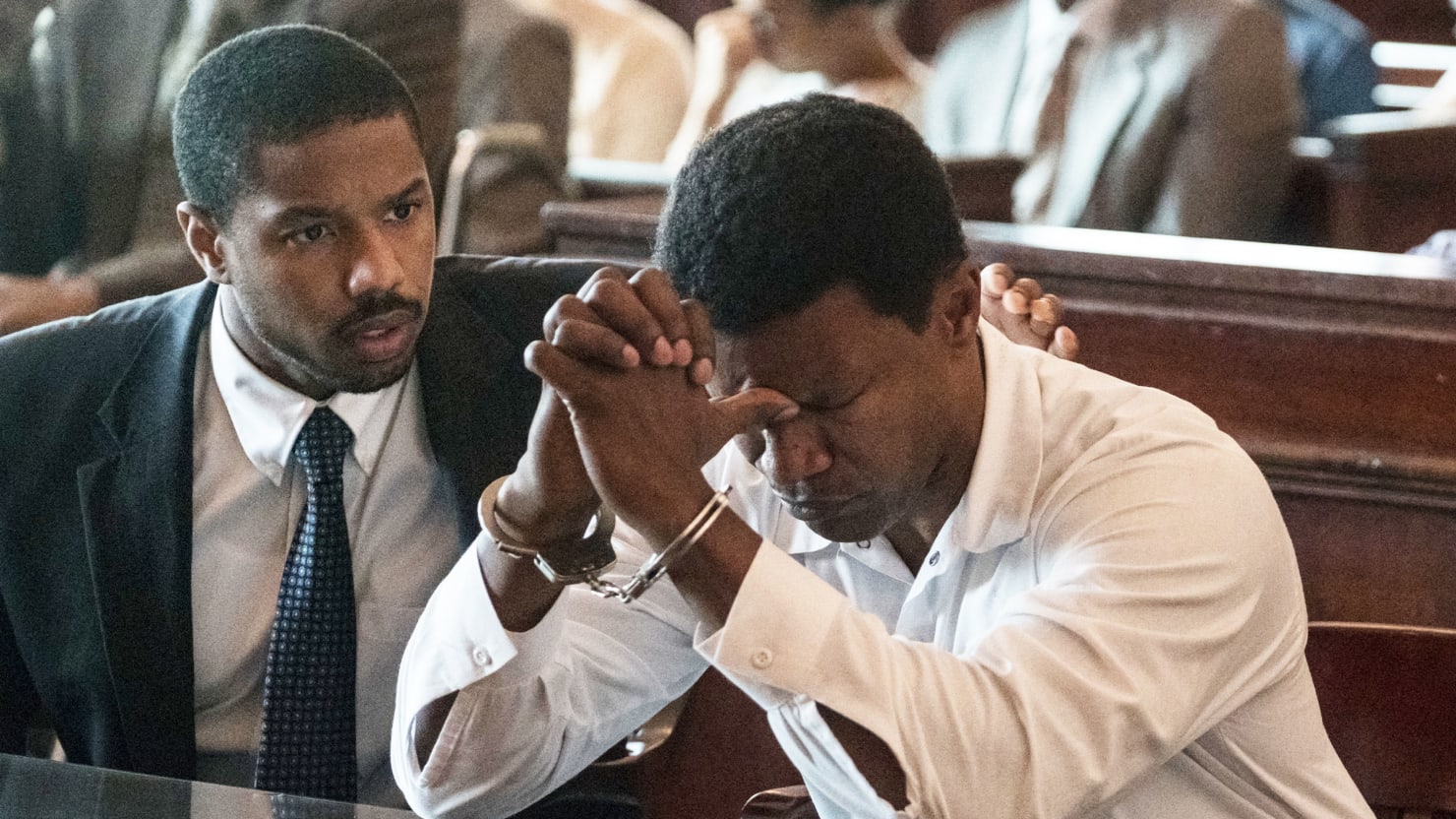Just Mercy

Synopsis: Lawyer tries to free an innocent man.
Michael B. Jordan stars in Just Mercy, based on attorney Bryan Stevenson’s book about his work to free a man from death row who was wrongfully convicted of murder in Alabama, USA in the late 1980s. Movie Loon is quite familiar with injustices of the cinematic kind, like when Amy Ryan–brilliant in 2007’s Gone Baby Gone — lost out to Tilda Swinton in Michael Clayton, but I hadn’t heard about this big time injustice that almost cost a person their life, and not just a shiny statue.
In 1988, Walter McMillian, who went by the moniker “Johnny D,” was convicted of murdering a teenaged clerk at a drycleaners in Monroeville, Alabama. Johnny D was a black man and the victim was a white woman. It seems that the police, short on evidence and leads, were eager to pin the crime on somebody. Too bad they weren’t as enthusiastic about actually solving the crime. Anyway, Johnny D is a self-employed logger and rumored weed dealer. Gossip made him well-known in town for being a married man who was having an affair with a married woman. Maybe not so notable in a big city, but Monroeville is a small town and the relationship was bi-racial.
Jamie Foxx is very good as Johnny D, showing us his despondency about getting vindicated and then, his tenative hope. Even better is Michael B. Jordan as his attorney. Bryan Stevenson is a young lawyer from up north who has graduated from Harvard Law. A federal grant has enabled him to set-up the Equal Justice Initiative to provide legal representation for the poor and/or wrongfully convicted persons. His mom is worried about him working in the Deep South. She’s right to worry. Once you see the things that happen to him and his client, you wouldn’t be surprised if at the figurative border to the Deep South is a sign that says “Welcome! and if You’re Black, Go Back!”
When Bryan Stevenson –let’s call him MBJ– gets to Monroeville, he is met by Captain Marvel. Yay!! Brie Larson plays Eva Ansley, the co-founder of the EJI project. I tried to remember if she had “met” MBJ in one of the Marvel movies. But then I remembered that charismatic MBJ did not play a good guy. He was Killmonger in Black Panther, so he wouldn’t be invited to any of the Marvel superhero shindigs.
Brie’s character is so committed to justice, that even when she and her family are threatened, she defiantly lifts her chin in the air and unbowed, declares that fighting on will make her family proud. Keep in mind that the people who threaten her are basically her neighbors. So, racism about her working with a black man? Speaking of racism…

Monroeville, Alabama is famous as the home of To Kill a Mockingbird author Harper Lee. The movie notes a few polite white people encouraging MBJ to visit the town’s TKAM museum. It’s not lost on the audience that the museum hasn’t eradicated Alabama’s race divide. There are white folks who quickly let MBJ know that he isn’t welcome. Instead of being impressed by his credentials, they resent a black Harvard grad coming down from the north and telling them how to do things.
When MBJ goes to speak with Johnny D in prison, a white guard attempts to humiliate him. One night, he’s pulled over by the cops for no reason. The district attorney, Tommy Chapman (Rafe Spall) didn’t prosecute the case, but he is determined to defend the verdict. He’d like MBJ to hightail it outta town, but, no! Before you know it, MBJ is running back and forth from the prison to his office, seemingly representing every man on death row.
Just Mercy’s narrative moves as expected, with lots of legal and morale setbacks. MBJ can’t save every man from the electric chair, and Johnny D gets his hopes for a new trial crushed time and again. But–of course– there are battles won along the way. A white witness, Ralph Meyers (Tim Blake Nelson), who is basically a career criminal, wavers about his “eye witness” account. We watch as he twists himself into knots justifying his testimony while alluding to police pressure. Nelson’s performance is spot-on in its cadence of the real man, as seen in a 1992 60 Minutes exposé on the case.
While the movie is predictable in some ways, the facts of the murder case and the documented collusion along the way keep our interest piqued. Who really killed the young woman? Why doesn’t MBJ just get back in his car and head home to Delaware? Why were the statements of dozens of black witnesses who placed him at a fish fry at the time of the murder discounted? And what are the hours of the To Kill a Mockingbird Museum, anyway?
P.S. In addition to the Monroe County Museum aka The Old Courthouse with its exhibits on the author Harper Lee, each spring there is a stage adaptation of TKAM performed in the old courthouse where Harper Lee would watch her lawyer father work.
Other notable sites in Alabama include: the Birmingham Civil Rights Institute with exhibits addressing Jim Crow and the civil rights movement. And Dexter Avenue King Memorial Baptist Church, in the state capital of Montgomery, where the civil rights movement’s most prominent leader, the Reverend Dr. Martin Luther King Jr. preached.
P.P.S. For more on this case check out the source material, Just Mercy: A Story of Justice and Redemption by Bryan Stevenson. Also, Pete Early’s Circumstantial Evidence: Death, Life, and Justice in a Southern Town.
Movie Loon’s Movie Review Shortcut:
Grade: B
Cut to the Chase: Strong performances anchor an important real life story
Humor Highlight: Ok, injustice isn’t funny, but Jamie Foxx’s wig mustache is.
